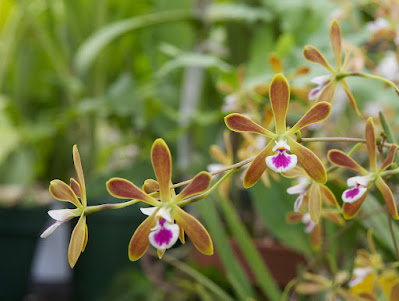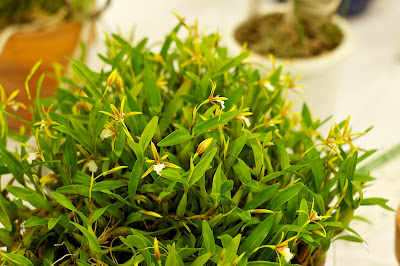Encyclia orchid flowers are smaller than 4 cm in diameter, showy, sometimes scented, greenish, white or brownish, pink or purple–maroon...
Encyclia orchid, also called as Doxosma, Sulpitia, is a genus in the Orchidaceae family. This genus was described by William Jackson Hooker in 1828.
DESCRIPTION OF ENCYCLIA ORCHID
Encyclia orchid is native to Florida, Mexico to Tropical America. All the species grow on tree or shrub branches in the wild. It is found growing in lowland forests, most common in dry oak forests at altitudes up to 2000 meters above sea level.
The plant of this genus are epiphytic or lithophytic, rarely terrestrial, caespitose which reaching to 110 cm in height with inconspicuous or elongate rhizome. The pseudobulbs are spherical, subovoid, ovoid, conic-ovoid, fusiform, pyriform or subpyiriform, heteroblastic, subtended by scarious bracts shredded with age. The leaves are generally two, rarely one, three or four, on short tubular petioles at apex of pseudobulbs.
These plants blooms from the apical, erect or arching, stout, smooth or warty, racemose or paniculate to 150 cm long inflorescences that are lacking of spathe with terete, to 45 cm long peduncle that are covered by tightly sheathing bracts. The flowers are smaller than 4 cm in diameter, showy, sometimes scented, greenish, white or brownish, pink or purple-maroon, inconspicuous to showy, blotched or striped with magenta. The column has no foot and is not attached to the lip for most of its length, and there are 4-8 pollina attached to the caudicles.
ENCYCLIA ORCHID CARE AND CULTURE
Cultural information should only be used as a guide, and should be to be adapted to suit you. Your physical location; where you grow your plants, how much time you have to devote to their care, and many other factors, will need to be taken into account. Only then can you decide on the cultural methods that best suit you and your plants.
Light:
Encyclia orchid needs a light level of 20000-35000 lux. The light should be filtered or diffused and the plants should not be exposed to direct midday sun. Strong air movement should be provided all the time.
Temperature:
These plant grow well in intermediate conditions. In summer, the average day temperature is 24-27 °C, and the night 14-16 °C, with a daily amplitude of 8-10 ° C. In winter the average daytime temperatures are 22-24 ° C, and 12-14 ° C during the night, while the daily amplitude is 8-11 ° C.
Humidity:
The species of this genus needs the humidity of 80% in the period of growth, in winter and spring it falls to 60-70%. Too dry air has a negative effect on the development of the plant: its growth is inhibited, and the leaves begin to turn yellow and dry out. The higher temperature, the higher the humidity should be, and the higher the humidity, the more often and longer it is necessary to ventilate the room where the plants are contained, otherwise the probability of rotting and various kinds of fungal diseases. Good air movement is essential while the plants are in leaf and growing.
Substrate, growing media and repotting:
Encyclia orchid grow well mounted on pieces of tree fern or cork, but in summer this requires high humidity and daily watering. In the period of extremely hot and dry weather, fixed plants may require even several watering times a day.
However, since most growers find it too difficult to maintain sufficient moisture with this growing method, these plants are usually grown in pots using an airy, fast-drying substrate that contains substances such as perlite to keep moisture out and charcoal to keep it airy and prevent acidification. Plants should be repotted at the end of winter or early spring, when new root growth begins.
Watering:
The plants should be watered abundantly during active growth, but their roots must dry out quickly after watering. At the end of autumn, the amount of water should be gradually reduced.
Fertilizer:
They should be fertilized every week 1/4-1/2 of the recommended dose of fertilizer for orchids. A fertilizer with a high nitrogen content is beneficial from spring to mid-summer, and a phosphorus-rich fertilizer can be used in late summer and autumn. Higher phosphorus content stimulates better flowering in the next season and promotes hardening of new growth before winter.
To avoid the accumulation of mineral deposits during periods of strong fertilization, it is recommended to rinse the containers approximately every month.
Rest period:
Encyclia orchid grown in cool conditions should be kept relatively dry in winter, with occasional fogging between rare waterings. However, those grown in warmer conditions need more water and significant drying up between waterings. However, it must not be allowed keep them dry for a long time. Fertilization should be reduced or eliminated until new growths appear and watering begins more abundantly in the spring.
BUY ENCYCLIA ORCHID AND RELATED PRODUCTS
SOME SPECIES AND VARIETIES OF ENCYCLIA WITH CARE TIPS
- Encyclia alata - Winged Encyclia
- Encyclia ambigua - Ambiguous Encyclia
- Encyclia asperula - Asperulous Encyclia
- Encyclia ceratistes - Horned-Columned Encyclia
- Encyclia chiapasensis - Chiapas Encyclia
- Encyclia chloroleuca - Green and White Encyclia
- Encyclia cordigera - Large-lipped Encyclia
- Encyclia diota - Two-eared Encyclia
- Encyclia dressleri - Dressler's Encyclia
- Encyclia flabellata - Fan Shaped Encyclia
- Encyclia gravida - Heavy Fruit Butterfly Orchid
- Encyclia guatemalensis - Guatemalan Encyclia
- Encyclia mooreana - Moore's Encyclia
- Encyclia oncidioides - Oncidium-Like Encyclia
- Encyclia papillosa - Butterfly Encyclia
- Encyclia peraltensis - Peralta Encyclia
- Encyclia plicata - Pleated Encyclia
- Encyclia polybulbon - Many Bulbed Encyclia
- Encyclia selligera - Saddle-lipped Encyclia
- Encyclia stellata - Starry Alanje Encyclia
- Encyclia suaveolens - Sweet-Smelling Encyclia
- Encyclia tampensis - Florida Butterfly Orchid
- Encyclia trachychila - Rough Lip Encyclia














COMMENTS